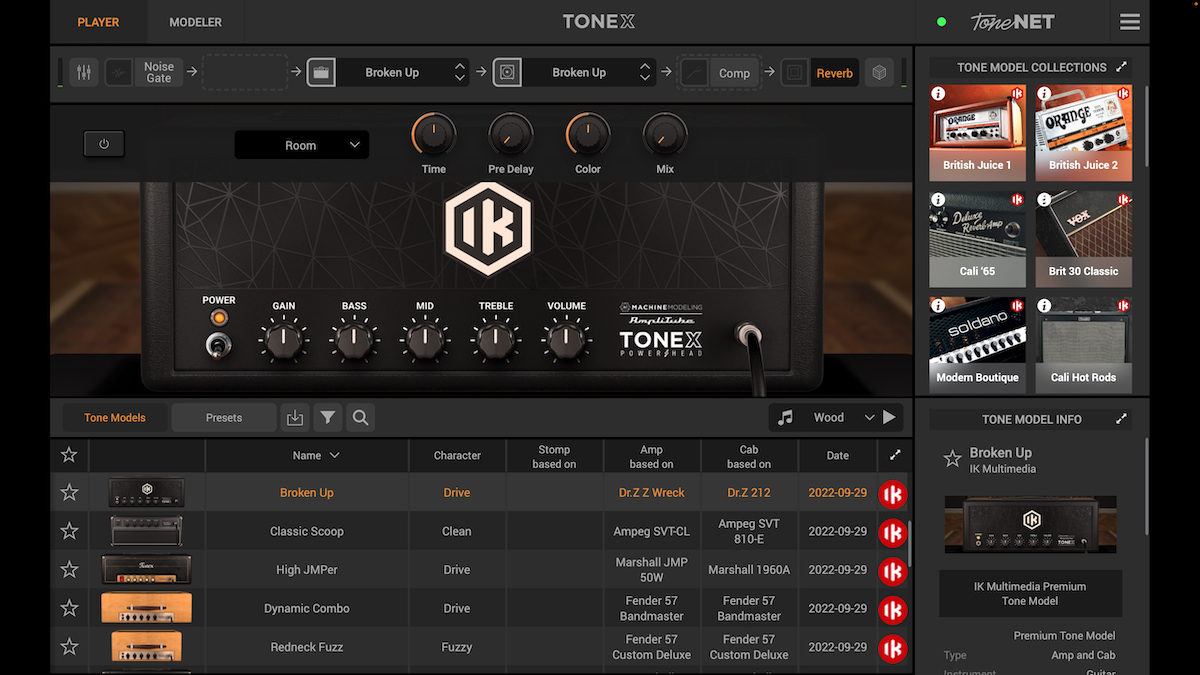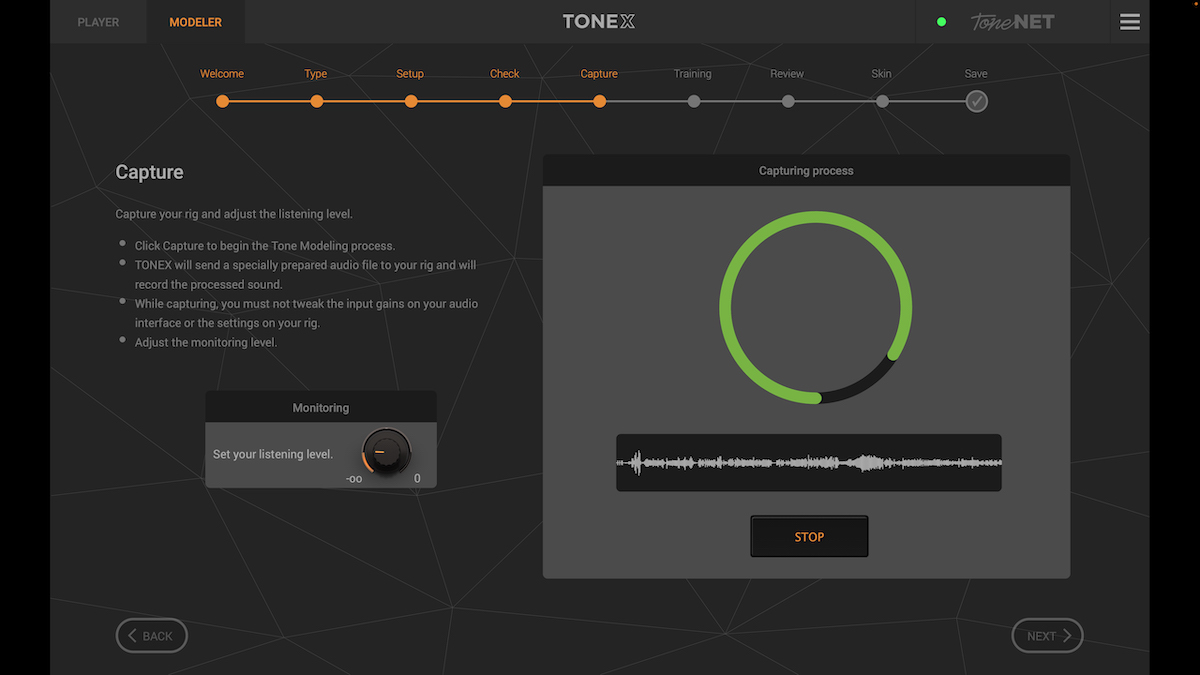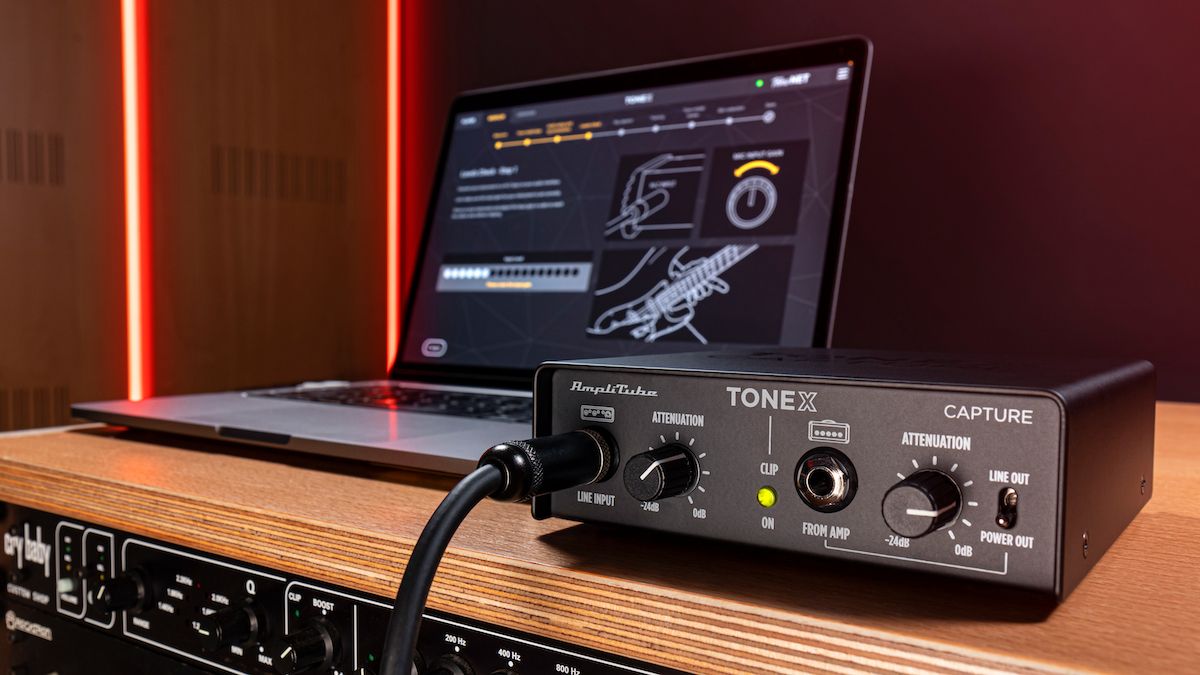Guitar World Verdict
TONEX is immensely impressive and endlessly entertaining. Modelling your own gear is fast, easy and astonishingly accurate, while cherry-picking existing models from IK Multimedia and its ToneNET community is both convenient and a real giggle.
Pros
- +
Authentic modelled tones
- +
A doddle to use
- +
Huge range of ready-made tones available
- +
Share tones with the ToneNET community
- +
Integrates smoothly with AmpliTube and the wider IK Multimedia ecosystem
- +
Inexpensive
Cons
- -
It cannot model time-based effects
- -
Requires a re-amp box or interface with re-amp capability
You can trust Guitar World
Make no mistake, TONEX’s jaw-dropping feature - its pièce de résistance, la cerise sur le gateau - is its ability to model your own guitar amplifiers and pedals. Believe me it’s really quite something, but we’re already getting ahead of ourselves. First, let’s look at what TONEX is, and what it’s not.
Compatibility: Mac, PC, iOS
TONEX CS: free
TONEX SE: $149.99/€149.99
TONEX: $149.99/€149.99
TONEX MAX: $249.99/€249.99
TONEX APP for iOS: free
Buy from IK Multimedia
TONEX is a software tone modeller for amps and stompboxes, a player and a library browser that runs on Mac and PC as either a standalone application or plugin for your DAW. There’s also a companion iOS app, and a piece of hardware called TONEX Capture that bridges your recording interface and amp or stompbox with the correct signal level. Essentially, it enables you to model your own kit, choose from more than 1,000 existing tones from IK Multimedia’s pro-modelled library or share gazillions of tones from the ToneNET online community.
What kind of tones are available? Everything from the filthiest tones imaginable to sounds that can only have been sculpted in a clean room. Fender Tweeds, Marshall stacks, dirty Diezels, bonkers Bogners – they’re all here.
Stompboxes aren’t so well represented because TONEX can’t handle time based effects, leaving only distortion, overdrive, fuzz, boost and so on. However, amps, cabs and pedals can be combined with a noise gate, compressor and reverb to form a TONEX Preset, a straightforward yet powerful signal chain that can be used in your DAW or for performance.
What TONEX is not, is AmpliTube. Where AmpliTube uses analog modelling technology to simulate the behaviour of the entire circuitry of an amp or pedal, TONEX uses what IK Multimedia calls AI machine modelling to simulate a specific tone. A snapshot, if you will, of a certain amp or stompbox setting. AmpliTube can also simulate an entire rig, with sophisticated routings, whereas TONEX is limited to its relatively simple preset structure.
If this sounds a bit limiting, fear not, because TONEX can run within AmpliTube, bringing the best of both worlds.
Capturing guitarists’ hearts

Back to the exciting bit, capturing your favorite tones. But hold on, if you already own an amp and you know how to get the best from it, why bother modelling it? There are a whole host of reasons.
All the latest guitar news, interviews, lessons, reviews, deals and more, direct to your inbox!
We all recognize that an amp at full throttle can sound fantastic due to the magic of natural compression, but it’s also true that neighbors rarely share our enthusiasm for driven tones. By modelling a cranked amp you get that same glorious tone but at a much lower volume, and you can even play using headphones, a feature your original amp may not offer.
I doubt your tube amp can load presets either? Model your favourite tones and you can recall them at a touch of a button or click of a mouse.
I also bet your expensive tube amp is heavy, less than 100 percent reliable and used by the enthusiastic crowd at your local pub night to stack their empties? Model away and your whole rig could comprise just your guitar, an iPad and a little pedalboard controller. Neat.
Of course, the likes of Neural DSP and Kemper have championed DIY modelling and profiling for years with impressive results. TONEX is different because the cost overhead is substantially lower, and IK Multimedia’s eco-system is considerably broader. It brings modelling to the masses.
The process couldn’t be easier, but you will need an interface with re-amp capability, or a separate re-amp box that’ll convert the line level signal from your interface to amp friendly instrument level. Conveniently, the little TONEX Capture box handles all this for you, while IK Multimedia’s Axe I/O series of interfaces offers an even more streamlined solution.

Once you’ve arrived at the tone you want to model it’s just a case of plugging your guitar, or bass, into your interface, routing the re-amp output signal to your amp and miking the cab up to an input on the same interface. Of course, you’re not limited to just modelling an amp, you can choose from an amp and cab/combo, an amp head, a stompbox or any combination of the three. Neither do you have to mic up a cab, if your head or combo has line outs then you can route them back to the interface instead.
If all this sounds a bit of a palaver, it’s not. Usefully, TONEX guides you through the entire process with colorful on-screen circuit diagrams, so once you’ve sussed the signal path it’ll take you two minutes. Then, it’s just a case of setting levels and hitting the Capture button. TONEX plays a variety of pre-recorded tones and guitar/bass patterns through your amp for about five minutes before processing the result in a step it calls Training. You get to choose from three levels of Training accuracy: fast, default and advanced. Default is the suggested level, and it took just over 10 minutes on this setting to build our models on a four-year-old Mac with a 3.2 GHz Intel i7 Processor and 16GB of RAM. We didn’t need to go any faster, but also didn’t want to wait much longer for little return in improved accuracy.
Fact is, at this setting every model we attempted sounded almost exactly like the original tone. To my ears, the very minor differences are explained by the unique sonic fingerprint of studio monitors and headphones vs the original cabs.
We modelled everything from an old Cornford Carrera 1x12 tube amp to a modern Fender ‘65 Fender Twin Reverb, and each time we were blown away by the realism. Just for fun, and to test how successful routing via line-outs would be, we modelled a Yamaha THR 100HD modelling head too, a now discontinued amp that sounds great but doesn’t have the facility to save presets. Now I have my favorite tones saved for posterity, an important consideration for any amp where spare parts may not be readily available in the future.
Now I have my favorite tones saved for posterity, an important consideration for any amp where spare parts may not be readily available in the future
Once modelled, there’s not much you can do to change a tone other than tweak EQ settings because, as previously mentioned, TONEX models a tonal snapshot rather than the entire amp or pedal at component level. That’s fine, if you’ve already arrived at a tone fit for modelling why change it?
Modelling clean sparkly tones dry does take a bit of getting used to, but thankfully reverb and compression can be added later when building a TONEX preset. Or, if you’re an AmpliTube user, you can further shape your TONEX tones in a multitude of ways.
IK Multimedia TONEX review: Conclusion

Once tried, I suspect many guitarists will wonder how they ever managed without TONEX. The opportunity to tame the volume of their magnificent but unruly tube amps will be a huge draw for many, plus the convenience of recording solely ‘in the box’. The massive library of existing tones from IK Multimedia and the ToneNET community is another very seductive feature, even if you’re unlikely to ever scratch the surface of what’s on offer.
Finally, the ability to shrink your entire gigging rig so that it runs on just AmpliTube, TONEX, iRig STOMP and an iPad still blows our minds. Why keep lugging that heavy combo amp around?
That TONEX can produce such startlingly accurate models so quickly and easily on modest computer equipment is an impressive achievement.
IK Multimedia TONEX review: Specification
The primary TONEX application for Mac and PC is available in four versions:
- TONEX CS is free. It includes 20 Tone Models, 10 Amps/5 Pedals and 20 User Tone Model Downloads. It lacks the facility to create models.
- TONEX SE is $149.99/€149.99. It includes 200 Tone Models, 20 Amps/10 Pedals and Unlimited Tone Model Creation and Unlimited User Tone Model Downloads.
- TONEX is currently on promotion at $149.99/€149.99. It includes 400 Tone Models, 40 Amps/20 Pedals and Unlimited Tone Model Creation and Unlimited User Tone Model Downloads.
- TONEX MAX is $249.99/€249.99. It includes 1,000 Tone Models, 100 Amps/50 Pedals and Unlimited Tone Model Creation and Unlimited User Tone Model Downloads.
- TONEX APP for iOS is free but offers in-app purchases.
- TONEX CAPTURE hardware costs $249.99/€249.99 but ships with TONEX SE included. It’s needed to model tones if your interface does not have a re-amp output or you don’t own a separate re-amp box. If you don’t own an interface then IK Multimedia’s AXE I/O line is worth considering because all models feature a re-amp output.
- More info: IK Multimedia
When Simon's childhood classical guitar teacher boasted he 'enjoyed a challenge', the poor man had no idea how much he'd underestimated the scale of the task ahead. Despite Simon's lack of talent, the experience did spark a lifelong passion for music. His classical guitar was discarded for an electric, then a room full of electrics before Simon discovered the joys of keys. Against all odds, Simon somehow managed to blag a career as a fashion journalist, but he's now more suitably employed writing for Guitar World and MusicRadar. When not writing or playing, he can be found terrifying himself on his mountain bike.


